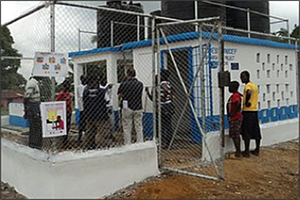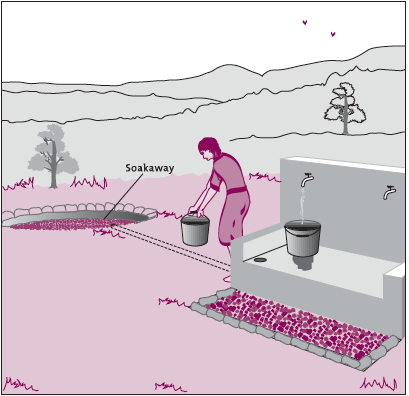Difference between revisions of "Public standpost"
(→Field experiences) |
|||
| (9 intermediate revisions by the same user not shown) | |||
| Line 1: | Line 1: | ||
| − | [[Image:standpost icon.png|right| | + | [[Image:standpost icon.png|right|80px]] |
| − | [[Image:public standpost.jpg|thumb|right| | + | [[Image:public standpost.jpg|thumb|right|200px|Public standpost. Drawing: WHO.]] |
| − | + | __NOTOC__ <small-title /> | |
A public standpost or tapstand distributes water from one or more taps to many users. Because it is used by many people it is often not looked after, and the design and construction must be sturdier than used in similar domestic connections. A standpost includes a service connection to the supplying water pipeline, a supporting column or wall made of wood, brick, dry stone masonry, concrete, etc, and one or more 0.5 inch (1.25 cm) taps that protrude far enough from the column or wall to make it easy to fill the water containers. The taps can be a globe or a self-closing type. | A public standpost or tapstand distributes water from one or more taps to many users. Because it is used by many people it is often not looked after, and the design and construction must be sturdier than used in similar domestic connections. A standpost includes a service connection to the supplying water pipeline, a supporting column or wall made of wood, brick, dry stone masonry, concrete, etc, and one or more 0.5 inch (1.25 cm) taps that protrude far enough from the column or wall to make it easy to fill the water containers. The taps can be a globe or a self-closing type. | ||
The residual pressure head of the water at the standpost should be 10–30m, and some standposts have a regulating valve in the connection to the mains that can be set and locked to limit the maximum flow. A water meter may also be included (see Fact Sheet 7.8 Domestic water meters). A solid stone or concrete apron under the taps, and a drainage system, lead spilled water away and prevent muddy pools from forming. A fence may be needed to keep cattle away. The location and design of a public standpost should be determined in close cooperation with future users. | The residual pressure head of the water at the standpost should be 10–30m, and some standposts have a regulating valve in the connection to the mains that can be set and locked to limit the maximum flow. A water meter may also be included (see Fact Sheet 7.8 Domestic water meters). A solid stone or concrete apron under the taps, and a drainage system, lead spilled water away and prevent muddy pools from forming. A fence may be needed to keep cattle away. The location and design of a public standpost should be determined in close cooperation with future users. | ||
| − | ==Construction, operations and maintenance== | + | ===Construction, operations and maintenance=== |
Water users clean and fill their containers at the tap (bathing and washing clothes are not usually permitted at the standpost itself). At all times, pools of water must be prevented. The tap site should be cleaned daily and the drain inspected. The drain must be cleaned at least once a month. Occasionally, a rubber washer or other tap part may have to be replaced, and the fence may need to be repaired. If the standpost structure becomes cracked, it must be repaired, and when wood rots it must be treated or replaced. | Water users clean and fill their containers at the tap (bathing and washing clothes are not usually permitted at the standpost itself). At all times, pools of water must be prevented. The tap site should be cleaned daily and the drain inspected. The drain must be cleaned at least once a month. Occasionally, a rubber washer or other tap part may have to be replaced, and the fence may need to be repaired. If the standpost structure becomes cracked, it must be repaired, and when wood rots it must be treated or replaced. | ||
| Line 20: | Line 20: | ||
— special attention should be given to how water is handled after collection at the standpost, to prevent the water from subsequently becoming contaminated. | — special attention should be given to how water is handled after collection at the standpost, to prevent the water from subsequently becoming contaminated. | ||
| − | ==Acknowledgements== | + | ===Field experiences=== |
| − | * Brikke, François, and Bredero, Maarten. ''[http://www | + | The following projects utilize standposts or tapstands. |
| + | <br> | ||
| + | {|style="border: 2px solid #e0e0e0; width: 40%; text-align: justify; background-color: #e9f5fd;" cellpadding="2" | ||
| + | <!--rsr logo here--> | ||
| + | |- style="vertical-align: top" | ||
| + | |[[Image:akvorsr logo_lite.png|center|60px|link=http://akvo.org/products/rsr/]] | ||
| + | <!--project blocks here--> | ||
| + | |- style="vertical-align: bottom" | ||
| + | |[[Image:rsr 727.jpg |thumb|center|140px|<font size="2"><center>[http://rsr.akvo.org/project/727/ RSR Project 727]<br>TESO North School and Community WASH Project</center></font>|link=http://rsr.akvo.org/project/727/ ]] | ||
| + | |[[Image:project 822.png |thumb|center|140px|<font size="2"><center>[http://rsr.akvo.org/project/822/ RSR Project 822]<br>Urban WASH II <br>in Monrovia</center></font>|link=http://rsr.akvo.org/project/822/]] | ||
| + | |} | ||
| + | |||
| + | <br> | ||
| + | |||
| + | ===Acknowledgements=== | ||
| + | * Brikke, François, and Bredero, Maarten. ''[http://www.who.int/water_sanitation_health/hygiene/om/linkingintro.pdf Linking technology choice with operation and maintenance in the context of community water supply and sanitation: A reference document for planners and project staff]''. World Health Organization and IRC Water and Sanitation Centre. Geneva, Switzerland 2003. | ||
Latest revision as of 00:10, 15 March 2014
A public standpost or tapstand distributes water from one or more taps to many users. Because it is used by many people it is often not looked after, and the design and construction must be sturdier than used in similar domestic connections. A standpost includes a service connection to the supplying water pipeline, a supporting column or wall made of wood, brick, dry stone masonry, concrete, etc, and one or more 0.5 inch (1.25 cm) taps that protrude far enough from the column or wall to make it easy to fill the water containers. The taps can be a globe or a self-closing type.
The residual pressure head of the water at the standpost should be 10–30m, and some standposts have a regulating valve in the connection to the mains that can be set and locked to limit the maximum flow. A water meter may also be included (see Fact Sheet 7.8 Domestic water meters). A solid stone or concrete apron under the taps, and a drainage system, lead spilled water away and prevent muddy pools from forming. A fence may be needed to keep cattle away. The location and design of a public standpost should be determined in close cooperation with future users.
Construction, operations and maintenance
Water users clean and fill their containers at the tap (bathing and washing clothes are not usually permitted at the standpost itself). At all times, pools of water must be prevented. The tap site should be cleaned daily and the drain inspected. The drain must be cleaned at least once a month. Occasionally, a rubber washer or other tap part may have to be replaced, and the fence may need to be repaired. If the standpost structure becomes cracked, it must be repaired, and when wood rots it must be treated or replaced.
Occasionally, the piping may leak and need to be replaced. A caretaker or tap committee may be appointed to keep the tap functioning and the surroundings clean, and to regulate the amount of water used. Committee members may also collect the fees for water use. Sometimes, water vendors are allowed to fill their tanks at public standposts at special rates, for resale to people living farther away.
Potential problems
— if social problems remain unsolved, or if the standpost is not conveniently located, this can lead to the tapstand not being maintained properly, or even vandalised;
— often, the taps are not closed after use, or even left open on purpose to irrigate a nearby plot, which can lead to water accumulation at the tapstand site;
— standposts at the end of a piped system often have insufficient water pressure;
— special attention should be given to how water is handled after collection at the standpost, to prevent the water from subsequently becoming contaminated.
Field experiences
The following projects utilize standposts or tapstands.
 TESO North School and Community WASH Project |
 Urban WASH II in Monrovia |
Acknowledgements
- Brikke, François, and Bredero, Maarten. Linking technology choice with operation and maintenance in the context of community water supply and sanitation: A reference document for planners and project staff. World Health Organization and IRC Water and Sanitation Centre. Geneva, Switzerland 2003.

